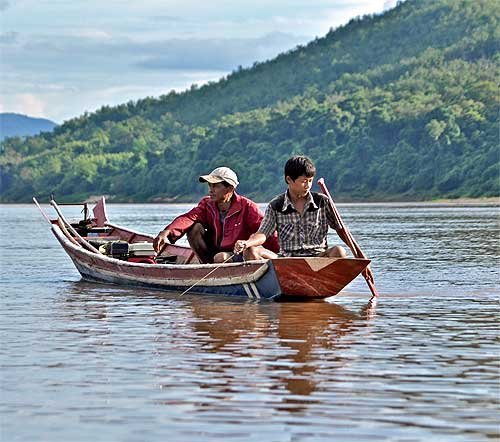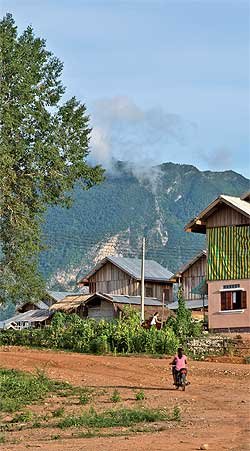Xayaburi Dam update
WAITING FOR A BITE: A father and son fish in the Mekong River at Sing village, opposite Sroi Luean.

New home not where the heart is for Xayaburi locals
Those relocated to make way for the construction of the controversial dam are sneaking back home to fish and forage after being torn from the traditional lifestyles they have relied on for centuries and finding themselves unable to make a living in their new surroundings
Published: 5/08/2012 at 02:04 AMNewspaper section: Spectrum
It's early in the morning, but 20-year-old Boonma looks exhausted due to a lack of sleep over the past three or four nights. His mother Ta, 54, is worried about her son's health and is not sure he is doing the right thing.
But both agree he has no choice given the situation.
For the past several days, Boonma and seven other Houay Souy villagers have travelled back to their homes near the Xayaburi Dam building site on the Lao side of the Mekong River. Since the beginning of the year they have been relocated to a new village, Ban Na Tor Mai, 40km from their traditional homes.
They have made the trip on motorbikes along potholed, dirt roads and sneaking onto the construction site. Once inside they make a secretive trip under cover of night on a boat to a temporary hut located on the river to do what they have done for decades _ fish.
''It's probably not worth the sweat, but we don't know what else to do,'' said Ta.
HIGHER GROUND: A view of the new village of Houay Souy near Xayaburi town.
Boonma and Ta's household was among 100 others relocated from their village of Houay Souy to make way for construction work, the first batch of 458 households along the river from Xayaburi to Luang Prabang in northern Laos to be moved.
They have been relocated despite the dam project not receiving the unanimous approval of the other Mekong River Commission (MRC) member countries, Thailand, Vietnam and Cambodia.
Several villagers told Spectrum that they were hurriedly moved from Houay Souy in January against their will.
Ta said the villagers were only informed about the relocation a few days before it took place. Several of them cried upon hearing the news and begged for the project's partner _ Thai construction company Ch Karnchang _ to reconsider its decision.
The villagers survive by gardening on the river banks, panning for gold and fishing.
''They said we must leave as it's the time to leave,'' said Ta. ''They said we should take whatever we want to take with us or our belongings would be destroyed. Some of us burst into tears as we didn't want to leave Houay Souy because we don't know how to make a living elsewhere,'' said Ta, shedding tears.
Ta's household is among 40 that has begged developers to reconsider their relocation. They have tried to negotiate with developers to persuade them to let them stay in nearby Ta Lan village. However, the developers said villagers there would also be moved to make way for the dam's construction.
Ta said she and other villagers were told the dam was a state project. ''We have to move out so that they can produce electricity,'' said Ta with a twinge of bitterness.
The relocated Houay Souy villagers were offered a new concrete two storey house, a monthly stipend of 120,000 kip (480 baht) per person per household for three years and compensation for teak trees felled to make way for construction. No compensation was paid for the loss of their fishing gear or their land, the villagers said.
SERVING NOTICE: : A sign in front of the new village reads 'Resettlement for Affected Persons of the Xayaburi Hydropower Project, Xayaburi'.
So far, 76 concrete houses have been built near Na Tor Mai village close to Xayaburi town, which is located in the mountains. Their new homes are near an area rife with orchards and crops, but these are harvested by Na Tor Mai villagers. Houay Souy villagers are shut out from the harvesting.
The villagers said they were promised new plots of land as part of the relocation but this has not happened.
They gather daily to discuss new ways to make a living and also to kill time, as there is little to do. Some have tried to open small shops but the competition for the limited number of customers there is fierce.
HIGHER GROUND: A view of the new village of Houay Souy near Xayaburi town.

Grocery shop owner, Nun, 31, said most of the relocated villagers were struggling to come to terms with life away from the river and many felt uncomfortable about venturing further afield to find work.
''We lived by the river all our lives and suddenly we have to live on a mountain. How are we going to survive? I really have no idea how we are going to survive being marginalised like this,'' said Nun.
Nun said despite their old homes being nothing but flattened ground, several villagers believed they had no choice but to travel back to Houay Souy despite being barred by developers.
Dissatisfaction is growing among the villagers as they realise that the payments are not enough to sustain them and that there is little chance of them becoming fishermen again. ''It will finish very soon and then what can we do next?'' said Nun. ''Our community will break down and there will not be Houay Souy any more,'' she said, brushing a gold pan, her only reminder of happier days on banks of the Mekong River.
CHANGES ON THE WAY: A man fixes his fishing net at Sroi Luean, a village in Luang Prabang which will also be partially flooded.
FOOD SECURITY 'UNDER THREAT'
The MRC's review of the Xayaburi Dam project released in March, 2011, covered the impact of the dam's construction, including how it would affect the ecosystem and fisheries as well as the relocation of villagers.
The report concluded that 458 households would need to be relocated to make way for the dam and that another 1,081 would suffer as a result of losing income from vegetable cultivation, gold panning and teak harvesting.
The MRC suggested that the matter be looked into in more depth, especially in relation to the impact on fisheries and villagers' livelihoods. It noted that fisheries have long been central to the lives of citizens of the four countries of the Lower Mekong Basin, especially communities living along a 15km corridor of the Mekong and its floodplains. Across the entire basin, some 40 million people _ about two-thirds of the population _ are involved in fisheries.
As such, the construction of the dam and related developments pose a direct threat to food security in Lower Mekong Basin countries, the report said. And this impact will be felt particularly by the poorest people in these countries, who overwhelmingly depend on river resources for food production, fishing and the gathering of aquatic animals and plants.
The review found that an estimated 29.6 million people were living within 15km of the mainstream Mekong. Laos had about 3.4 million living in this zone, with 79% within five kilometres of the mainstream. Most of these people farm and fish, with the report stating that the most impoverished households list fishing as a full-time occupation.
The MRC's report looked at the potential impact of six planned mainstream dams in northern Laos. It stated that if they were to be built, the dams would result in fish losses of 66,000 tonnes per year and would put the livelihoods of some 450,000 people at risk.
'FAIR' COMPENSATION
Laos hired global consulting and engineering firm Poyry to conduct a detailed investigation into how the dam would impact the lives of villagers living within a 15km corridor along the river. The company focused specifically on how river bank gardens, fisheries and other aquatic animals and flora used by villagers would be affected.
UNEXPECTED FIND: This woman found an earring while panning for gold in the Mekong River.
Poyry said that this information would prove crucial in determining a fair level of compensation for affected villagers and to protect developers from unjustified claims in the future. The consultancy firm said Ch Karnchang and the Lao government conducted public consultations with community leaders between 2007 and 2010. Additional meetings were held with people identified as affected parties between April, 2009, and August, 2010.
However, resettlement plans were also being carried out while the consultation process was under way.
According to the first progress report on the resettlement obtained by Spectrum, the request to build a new village was submitted to the Provincial Resettlement and Livelihood Restoration committee on March 31, two weeks before the supposed end of the regional consultation process.
On April 4, the Lao government approved a compensation policy and rate for those affected by the construction of the Xayaburi Dam.
July 16, Laos' Deputy Minister of Energy and Mines Viraphonh Viravong told visiting foreign delegates in Luang Prabang that his government would use the same standards set by the World Bank in dealing with people affected by the Nam Theun 2 dam in the Xayaburi case.
These standards call for houses and public utilities to be built in the new villages and for a programme to be introduced to help villagers find new livelihoods. Little of this was in evidence in the new area set aside for the Houy Souy villagers.
Thanks to Mac's sharp eyes &
New home not where the heart is for Xayaburi locals | Bangkok Post: news


